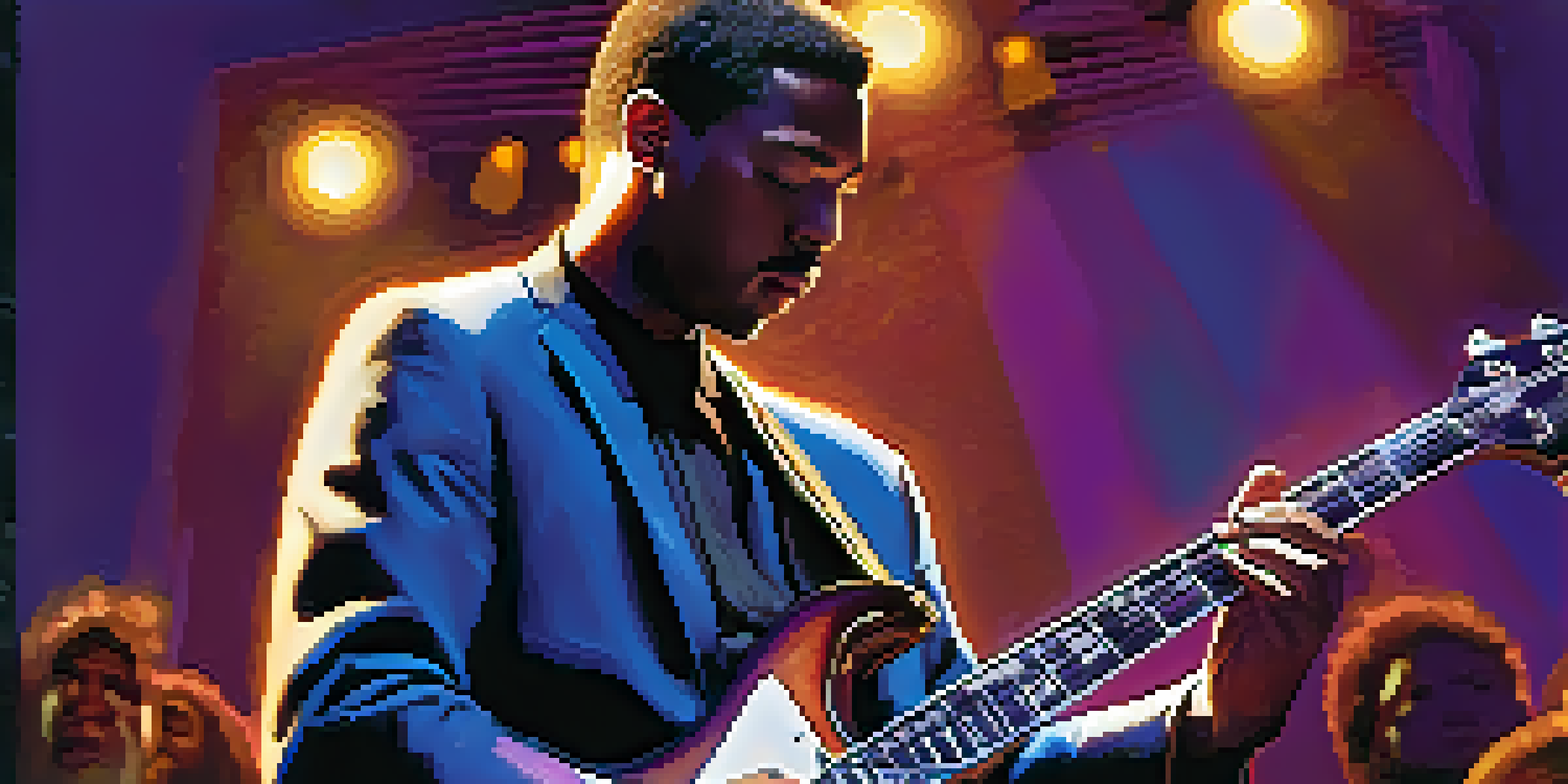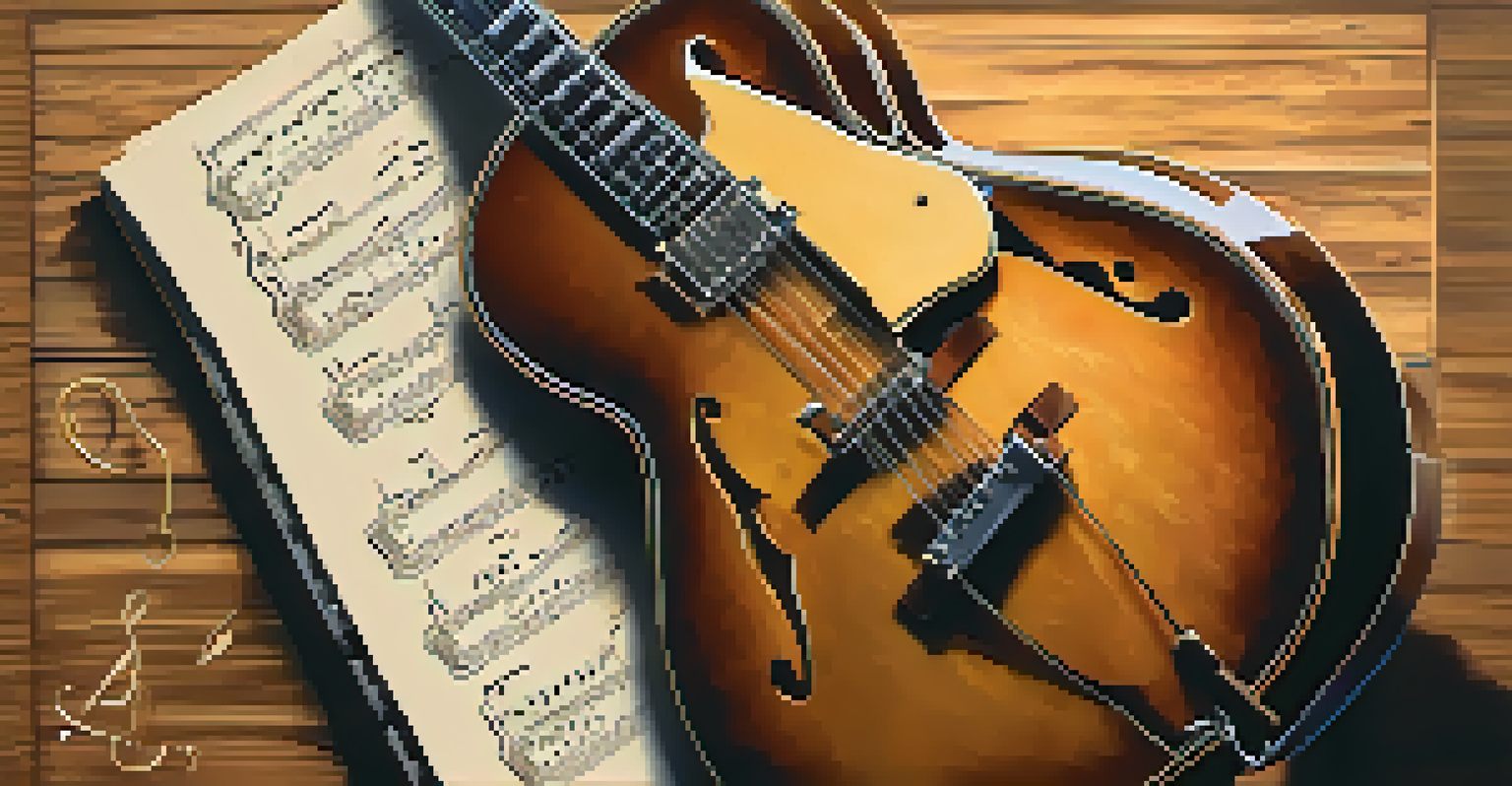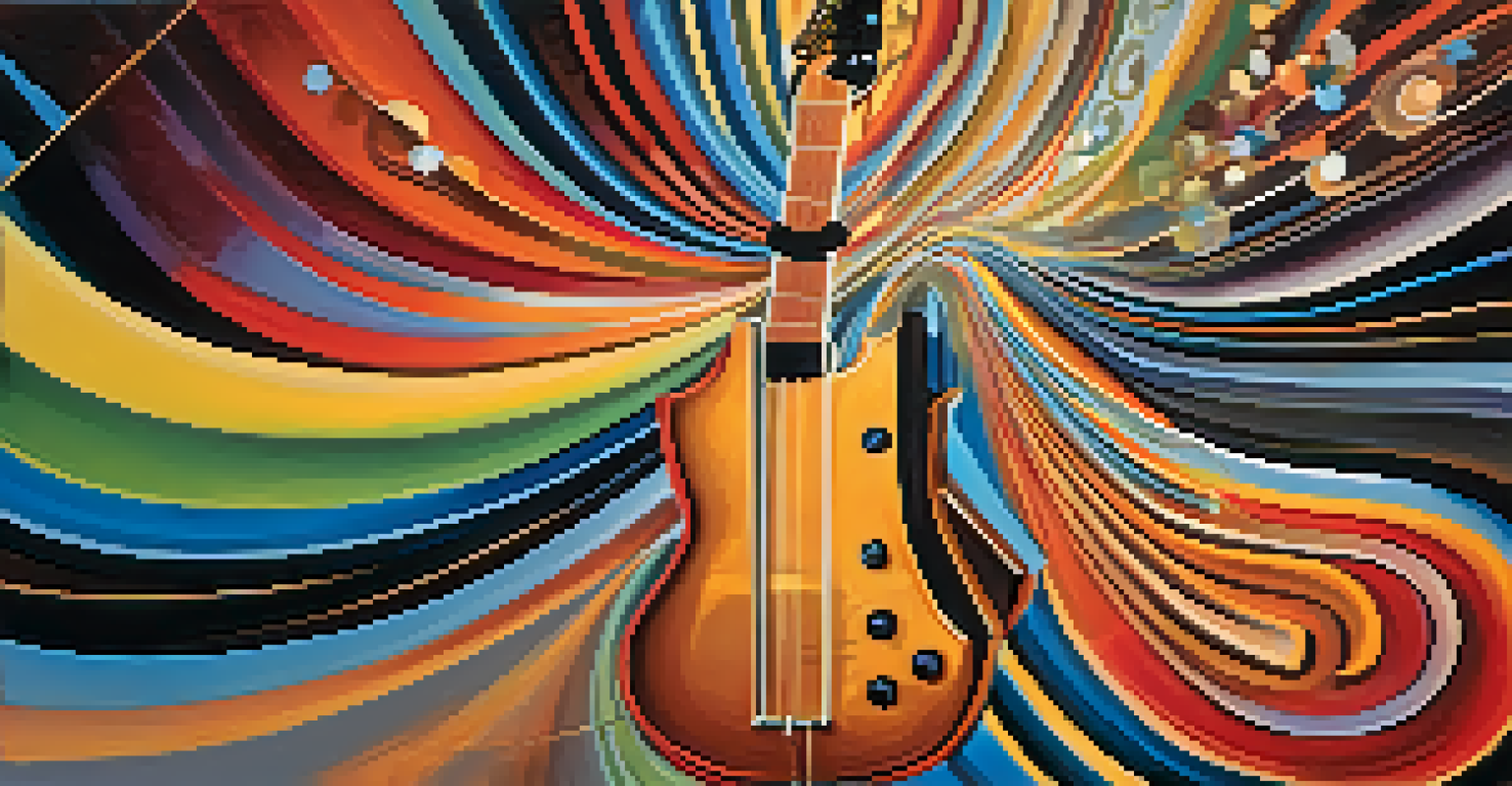Jazz Guitar Improvisation: Understanding Complex Chords

The Essence of Jazz Guitar Improvisation
Jazz guitar improvisation is all about freedom and creativity. Unlike classical music, where the notes are often set in stone, jazz invites musicians to experiment and express their emotions through spontaneous creation. This flexibility allows guitarists to explore various musical ideas, making each performance unique.
Jazz is not just a music genre; it’s a way of life, a way of expressing oneself without limits.
Central to jazz improvisation is the ability to navigate complex chords. These chords often include extended tones, such as 7ths, 9ths, and 13ths, which add richness to the music. Understanding how to break down these chords can help you craft solos that resonate with listeners, creating an engaging musical journey.
Moreover, improvisation is not just about playing the right notes; it's about telling a story. By weaving together melodies that fit within the framework of complex chords, guitarists can evoke feelings and paint vivid musical landscapes, captivating their audience.
Understanding Complex Chords in Jazz
Complex chords in jazz often involve more than just the basic triads. They can include added tones, alterations, and substitutions, which can be daunting at first. For instance, a Cmaj7 chord (C-E-G-B) can easily transform into a Cmaj7#11 (C-E-G-B-F#) by adding a sharp 11th, enriching its sound and texture.

To get comfortable with these chords, start by practicing them in isolation. Familiarize yourself with how they sound and how they relate to one another on the fretboard. This foundational knowledge will empower you to incorporate them seamlessly into your improvisation, enhancing your overall musical expression.
Jazz Improvisation Emphasizes Freedom
Jazz guitar improvisation encourages musicians to express their emotions through spontaneous and creative musical exploration.
Additionally, understanding the function of these chords within a progression is crucial. For example, knowing that a ii-V-I progression often leads to resolution can help you anticipate changes and create more dynamic solos that align with the harmonic structure of the piece.
Techniques for Navigating Complex Chords
When it comes to improvising over complex chords, various techniques can help you stay grounded. One effective method is using arpeggios, which allow you to outline the chord tones as you play. By practicing arpeggios for different chord shapes, you can create fluid melodies that highlight the richness of the chords.
Improvisation is the ability to see the world in a different way and to express that vision through music.
Another technique is to employ chromaticism, which involves using notes outside the chord to add tension and interest. For example, if you're improvising over a G7 chord, you might include notes from the G altered scale to create a sense of movement and surprise. This approach can elevate your solos and engage your audience more deeply.
It's also beneficial to explore modes and scales that align with complex chords. For instance, when faced with a minor 7b5 chord, the locrian mode can provide a solid framework for improvisation. By experimenting with different scales, you can discover new sounds and textures that enhance your musical vocabulary.
Listening and Learning from Jazz Masters
One of the best ways to improve your improvisation skills is by listening to jazz guitar greats like Wes Montgomery, Joe Pass, and Pat Metheny. Pay attention to how they navigate complex chords and the techniques they employ in their solos. This active listening can help you internalize different approaches and inspire your own creativity.
Transcribing solos is another powerful tool for learning. By picking apart and writing down the solos of your favorite jazz guitarists, you can gain insight into their thought processes and chord choices. This exercise not only improves your ear but also expands your understanding of how to improvise over complex harmonic structures.
Mastering Complex Chords is Key
Understanding and practicing complex chords allows guitarists to enhance their improvisational skills and create engaging solos.
Finally, consider playing along with recordings. Jamming with backing tracks or real musicians allows you to practice improvisation in a live context. This experience can help you apply what you've learned and develop your unique voice within the jazz genre.
Practicing Improvisation Effectively
To truly master improvisation, structured practice is essential. Set aside time to focus specifically on improvising over complex chords, using a metronome or backing tracks to keep time. Gradually increase the tempo as you become more comfortable, allowing your skills to develop progressively.
Incorporate a variety of exercises into your practice routine. For example, you might try improvising with different rhythmic patterns or using specific scales that correspond to the chords you're working on. This diverse approach will keep your practice sessions engaging and help reinforce your understanding of harmony.
Additionally, record your practice sessions and listen back. This allows you to critique your playing objectively, identifying areas for improvement. Over time, you'll notice your confidence and fluidity increase, making your improvisational skills more intuitive and natural.
Exploring Different Jazz Styles
Jazz is a diverse genre with various styles, each offering unique opportunities for improvisation. From bebop to smooth jazz, each style features distinct rhythms, harmonies, and improvisational techniques. Exploring these different styles can broaden your musical horizons and inspire new ideas.
For instance, in bebop, the emphasis is often on complex chord changes and fast tempos, requiring quick thinking and adaptability. Conversely, in styles like bossa nova, the focus shifts to more relaxed rhythms and melodic lines, allowing for a different exploration of complex chords. Adapting your improvisation to fit these styles can enhance your versatility as a guitarist.
Learning from Jazz Masters Inspires Growth
Listening to and transcribing solos from jazz greats can deepen your understanding of improvisation and enrich your personal style.
Engaging with different jazz styles not only enriches your playing but also connects you with a broader musical community. Collaborating with musicians from various backgrounds can introduce you to new perspectives, techniques, and ultimately, a more profound understanding of jazz improvisation.
Bringing It All Together: Your Improvisation Journey
As you dive deeper into jazz guitar improvisation and complex chords, remember that this journey is ongoing. Each practice session, performance, and listening experience contributes to your growth as a musician. Embrace the challenges and celebrate your progress, no matter how small.
Additionally, stay open to experimentation. Don't be afraid to try new techniques, explore different styles, or even break the 'rules' of improvisation. This willingness to experiment will lead to personal discoveries and a more authentic expression of your musical voice.

Ultimately, the goal of jazz guitar improvisation is not just technical mastery but genuine expression. By understanding complex chords and honing your improvisational skills, you’ll be well-equipped to create music that resonates with both you and your audience, making every performance a unique experience.